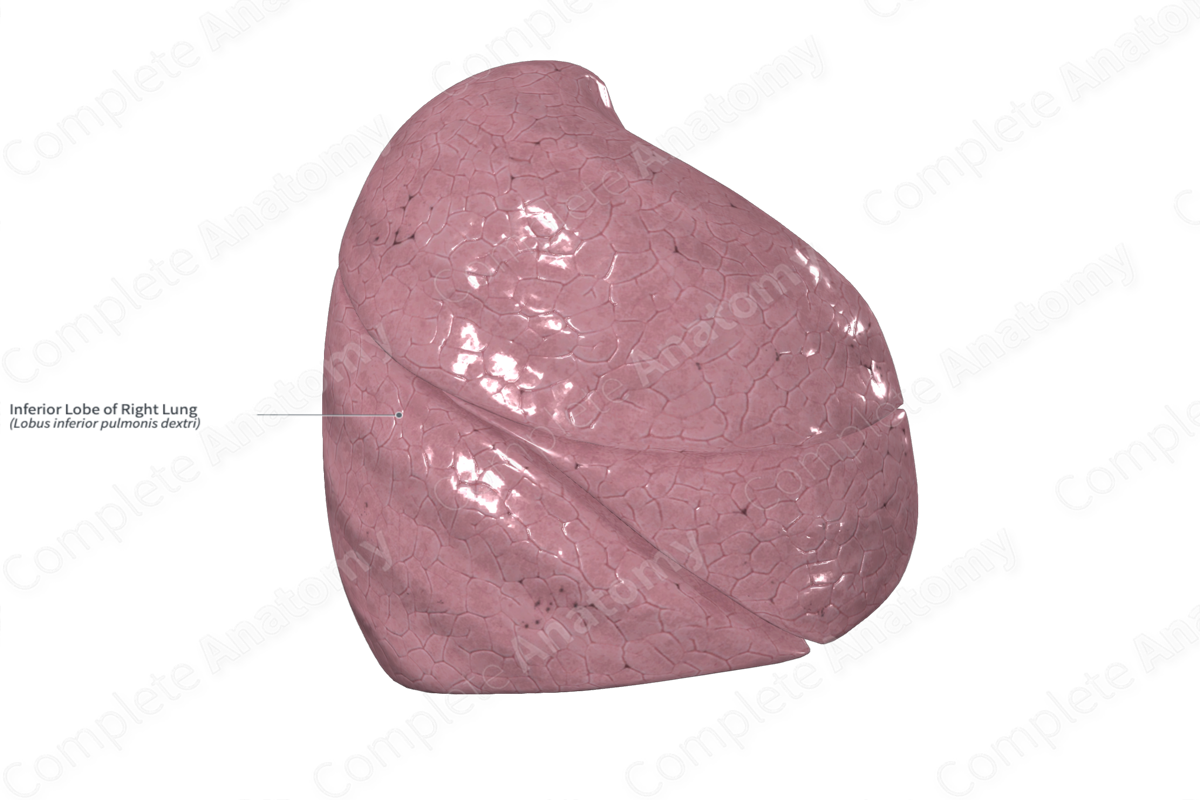
Quick Facts
Location: Right side of the thoracic cavity.
Arterial Supply: Right bronchial arteries.
Venous Drainage: Right bronchial veins.
Innervation: Pulmonary plexus.
Lymphatic Drainage: Superficial and deep lymphatic plexuses, bronchopulmonary and intrapulmonary lymph nodes.
Related parts of the anatomy
Structure
The right lung is divided into three lobes, which are separated by the oblique and horizontal fissures. These are the superior, middle, and inferior lobes. The inferior lobe of the right lung forms a portion of the costal, mediastinal, and diaphragmatic surfaces and the bulk of the posterior border of the right lung.
Like the inferior lobe of the left lung, the inferior lobe of the right lung is subdivided into five bronchopulmonary segments; the superior, medial basal, lateral basal, anterior basal, and posterior basal bronchopulmonary segments. Each of these bronchopulmonary segments has its own segmental bronchus and segmental artery.
Anatomical Relations
The inferior lobe of the right lung sits inferior to the oblique and horizontal fissures. The oblique fissure begins on the mediastinal surface, at the posterosuperior margin of the hilum. It courses in a superoposterior direction, to the posterior border of the lung, 6 cm inferior to the apex. It descends anteriorly along the costal surface as far as the anterior portion of the inferior border. It then continues onto the mediastinal surface and extends as far as the inferior border of the hilum. It is similar to the oblique fissure of the left lung, but it is not as vertically orientated.
The horizontal fissure is shorter and extends from the oblique fissure approximately at the mid-axillary line. It passes horizontally in an anterior direction at the level of the fourth costal cartilage and on to the mediastinal aspect of the lung, where it extends as far as the hilum.
The inferior lobe of the right lung sits over the right hemidiaphragm. Therefore, the inferior lobe on the right is in close proximity to the liver.
Function
The lungs are involved in respiration, which is the process of gas exchange between the atmospheric air and the blood. The lungs consist of lung parenchyma and supportive connective tissue. The lung parenchyma is the functional tissue of the lungs, where gas exchange occurs with pulmonary capillaries; it is composed of alveolar ducts and alveoli.
Arterial Supply
The right and left bronchial arteries are distal branches of the thoracic aorta. They supply oxygenated blood to the tissues of the tracheobronchial tree and the visceral pleura.
Venous Drainage
The bronchial veins that drain the more proximal regions of the tracheobronchial tree drain into the heart via azygos and accessory hemiazygos veins (i.e., via the systemic circulation). The bronchial veins that drain the more distal regions of the tracheobronchial tree form anastomoses with pulmonary veins and drain back to the heart via these veins (i.e., via the pulmonary circulation).
Innervation
The nerve supply to the lungs and visceral pleurae is via the pulmonary plexus. The pulmonary plexus provides autonomic (i.e., visceral) innervation to these structures, and it consists of both parasympathetic and sympathetic fibers.
- Parasympathetic stimulation within the respiratory system promotes bronchoconstriction, vasodilation of pulmonary blood vessels, and secretion from glands within the walls of the tracheobronchial tree.
- Sympathetic stimulation promotes bronchodilation, and vasoconstriction of pulmonary blood vessels.
Lymphatic Drainage
The lymphatic drainage system within the lungs can be divided into two plexuses; the superficial plexus and the deep plexus.
- The superficial lymphatic plexus (or subpleural plexus) is located within the lung parenchyma adjacent to the visceral pleura. This plexus provides lymphatic drainage to the superficial regions of the lungs and the distal ends of the tracheobronchial tree. It drains into the bronchopulmonary lymph nodes.
- The deep lymphatic plexus is located within the walls of the proximal tracheobronchial tree and the lung parenchyma adjacent to it. This plexus drains these areas, and, in turn, drains into the intrapulmonary lymph nodes.
List of Clinical Correlates
- Lung cancer
- Pulmonary collapse (atelectasis)
- Lung resection

